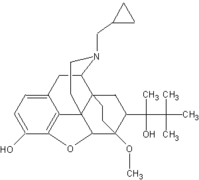Drug and alcohol addictions target the pleasure areas of the brain. With long-term use, brain chemistry changes. The number of dopamine receptors in the these pleasure areas decreases, and more stimulation is needed in order to feel normal. In an attempt to address this altered biochemistry, other drugs, considered less harmful, are available to help treat heroin and alcohol addictions. No drugs have yet been developed that can block the activity of cocaine and methamphetamine.
For heroin addicts, methadone, a synthetic addictive drug, is available through specially-licensed treatment facilities. Like heroin, methadone attaches to mu receptors, resulting in a decrease in the transmission of pain signals and an increase in dopamine. It has a milder and longer lasting effect than heroin, however, and can be taken orally. According to Newsweek reporter Geoffrey Cowley, "...addicts in methadone programs are more likely to have jobs, less likely to commit crimes and less prone to HIV infection."
In contrast to methadone, which has a similar effect to heroin, the prescription drug naltrexone (Revia) prevents heroin from attaching to mu receptors, sending active drug users who take it, abruptly into withdrawal. Naltrexone is primarily used by former users to prevent a relapse. The FDA is expected to approve a new drug, buprenorphine, that has the same effect as a very low dose of methadone. Buprenorphine does not cause an intoxicating high, even at high doses. Reckitt Benckiser Pharmaceuticals (Richmond, Virginia) wants to sell it as Suboxone, an under-the-tongue-lozenge available by prescription.
The FDA is also reviewing a pill currently used in Europe to treat alcoholism, called acamprosate. The National Institute on Alcohol Abuse and Alcoholism (NIAAA) is studying the effect of acamprosate when it used in combination with the anti-craving pill naltrexone and with counseling. The drugs are being viewed merely as an aid for alcoholics who are already motivated to quit drinking; no one views them as a cure.
Ibogaine, a botanical hallucinogen that is illegal in the US, is being used elsewhere to treat many addictions. Unlike the pharmaceuticals mentioned, ibogaine is taken once to ease withdrawal and to help addicts shift their view of themselves and their lives. Deborah Mash, a neuropharmacologist at the University of Miami, has studied ibogaine's use at the Healing Visions Institute for Addiction Recovery on St. Kitts in the West Indies for five years. Writer Geoffrey Cowley quotes Mash as saying: "It doesn't work for everyone...but for detox from opiates it's a slam dunk." People with cocaine and alcohol addictions have also reported benefits.
"New Ways to Stay Clean" by Geoffrey Cowley. Newsweek, February 12, 2001
"Can This Pill Stop You from Hitting the Bottle?" by Claudia Kalb. Newsweek, February 12, 2001
COPYRIGHT 2001 The Townsend Letter Group
COPYRIGHT 2001 Gale Group



